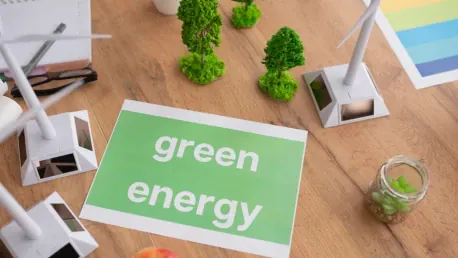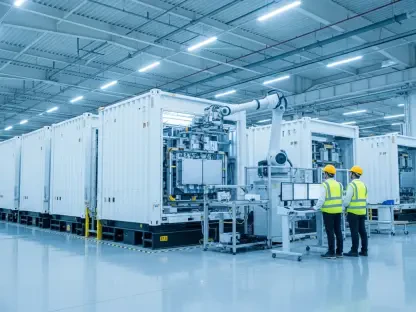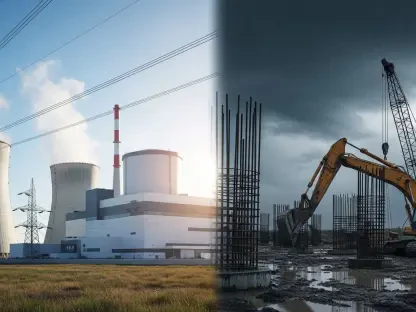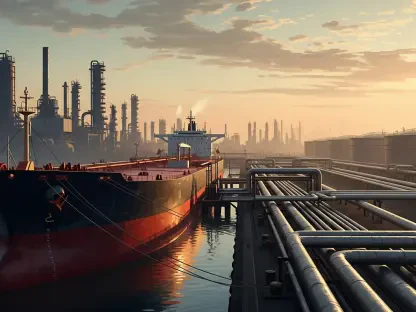President Donald Trump’s early executive actions reveal a discord between his vision for American manufacturing revival and his fossil-fuel-driven agenda. By rolling back the environmental initiatives of his predecessor, Joe Biden, and defunding green energy advancements, Trump’s policies threaten to counteract the growth in U.S. manufacturing driven by clean technology investments. These conflicting goals paint a picture of an administration at odds with itself, struggling to balance traditional energy interests with the undeniable progress of green technology.
Withdrawal from the Paris Climate Agreement
Trump’s Strategic Moves
Trump’s decision to withdraw from the Paris Climate Agreement marks a significant departure from global climate change measures. His administration views these initiatives as antithetical to American primacy, prioritizing traditional fossil fuel industries over emerging green technologies. This move underscores the administration’s overarching skepticism toward climate change initiatives and its emphasis on bolstering the fossil fuel sector. Trump’s strategic shift highlights a broader agenda aimed at minimizing regulatory constraints on traditional energy industries, which he believes will revitalize American manufacturing.
However, this approach raises questions about long-term sustainability and global competitiveness. Critics argue that by stepping away from international climate accords, the U.S. risks isolating itself from a global economic transition towards greener practices. In doing so, Trump’s policies may undermine the country’s leadership in technological innovation and environmental stewardship. This inward-looking strategy could have repercussions beyond environmental degradation, potentially eroding the U.S.’s standing in the global economic arena as nations worldwide pivot to sustainable energy solutions.
Implications for U.S. Manufacturing
This radical shift in climate policy creates several complications. Trump’s determination to bolster American industry and limit reliance on foreign manufacturing is at odds with his opposition to clean energy. Green technologies have become crucial investments propelling the U.S. manufacturing sector’s development. Trump’s environmental rollbacks may inadvertently stymie this sector’s progress, contradicting his promises to rejuvenate American manufacturing and foster job growth. As industries increasingly turn to sustainable practices to boost efficiency and reduce costs, sidelining green technology could hinder innovation and competitiveness.
Moreover, the growing consumer demand for environmentally responsible products puts additional pressure on manufacturers to integrate green technologies. By restricting advancements in clean energy, Trump’s policy reversal may force American manufacturers to fall behind international competitors who are embracing sustainable practices. This discrepancy poses a risk not only to the environment but also to the economic vitality and growth potential of the U.S. manufacturing sector. Failure to keep pace with global trends may result in lost opportunities and diminished market share, contrary to the administration’s objectives of economic resurgence.
Deregulation of Environmental Policies
Halting Funding for Green Energy
Trump’s plan to cancel mandates for electric vehicles (EVs) and reduce regulations favoring clean energy undermines the manufacturing sector’s critical transition towards green technology. These actions threaten to disrupt the gains made in adopting sustainable energy sources and shifting towards a greener industrial framework. In the long term, these efforts might impede the renaissance of American manufacturing by slashing essential green investments and distancing the U.S. from the increasingly eco-conscious global economy. Regulatory rollbacks risk creating an unfavorable environment for green tech innovation.
Additionally, removing funding for green energy initiatives sends a discouraging signal to investors and innovators in the sector. Such policies may stifle the entrepreneurial spirit that has been driving significant advancements in clean technology. The lack of governmental support for green initiatives could lead to reduced research and development, potentially causing the U.S. to lag behind other nations that continue to prioritize sustainability. This shift in focus creates a precarious scenario where the growth of green industries is severely hampered, negatively impacting job creation and economic diversification.
Economic Benefits of Green Investments
The tangible economic benefits resulting from Biden’s Inflation Reduction Act (IRA) stand in stark contrast to Trump’s deregulatory stance. This act, though criticized by Trump, has driven significant green investments and manufacturing jobs, particularly in Republican districts. Lawmakers, such as Congressman John James, acknowledge the benefits of the IRA, despite opposing its broader policy implications. James notes that while much of the IRA is detrimental, its sector-wide energy tax provisions are vital for manufacturers and job creators in his district and nationwide.
The success of the IRA highlights how targeted green investments can spark substantial economic growth, counteracting the narrative that environmental regulation inhibits industrial development. By incentivizing clean energy projects and technology, the IRA has spurred private sector engagement, fostering innovation and employment. Trump’s policies, which seek to dismantle these advancements, could reverse the positive economic trends fueled by the act, undermining the job creation and manufacturing gains that have been achieved. The divergence between the two administrations’ approaches underscores the complex interplay between environmental policy and economic strategy.
Impact on Local Economies
Surge in Private Sector Investments
Statistics support the notion of a burgeoning green manufacturing sector. Since 2022, private sector investments in clean energy and EV technology have reached $133 billion, with $89 billion devoted to manufacturing alone. This investment surge underscores a realistic and robust green manufacturing boom significantly contributing to local economies. These substantial financial commitments illustrate the confidence investors have in the long-term viability and profitability of green technologies, highlighting the potential economic benefits of sustainable industry.
The ripple effects of these investments extend beyond immediate job creation, fostering a more dynamic and resilient local economy. Increased demand for green technologies stimulates supply chain expansion, infrastructure development, and ancillary services, all of which contribute to broader economic growth. Furthermore, the emphasis on sustainability attracts talent and businesses seeking to align with eco-friendly practices, positioning these regions as hubs of innovation and excellence. The infusion of capital into green manufacturing demonstrates the transformative potential of environmentally conscious policies on local and national economic landscapes.
Case Studies: Georgia and North Carolina
Specific districts, like Georgia, are highlighted as models of transformation with $15 billion in IRA-driven investments leading to the creation of 43,000 new green jobs and projected substantial economic growth. The investments have revitalized local economies, proving that green initiatives can be powerful drivers of economic development. This shift not only creates employment opportunities but also improves the quality of life for residents by fostering sustainable practices and reducing environmental impact. Georgia’s experience serves as a compelling argument for the potential of green policies to rejuvenate regional economies.
Similarly, North Carolina’s Randolph County stands as a testament to green technological advancement, having secured the largest U.S. green tech investment in history. Funds approximating $14 billion have empowered Toyota to construct a manufacturing megasite poised to create 5,000 jobs by 2030, with significantly higher-than-average local wages. This site will eventually produce enough batteries to sustain up to 500,000 EVs annually. The project exemplifies how targeted green investments can lead to significant economic benefits, catalyzing industrial growth and job creation while promoting environmental sustainability.
Industry Perspectives
Elon Musk and Tesla
Elon Musk, CEO of Tesla, emerges as an influential figure amid these developments. While Musk disapproves of regulatory interventions that boost competition, he acknowledges that Trump’s policies on securing critical minerals for EV production may favor Tesla. Musk’s viewpoint suggests that while some subsidies may be lost, the negative impact on competitors grappling for raw materials could ultimately benefit Tesla. This perspective underscores the complex dynamics within the green tech industry, where policy decisions can have multifaceted and sometimes contradictory effects on different players.
However, relying on such advantages may come at the cost of broader industry progress. The broader implication of Trump’s policies may result in a less competitive and innovative market overall. While Tesla might gain an edge, the overall stagnation in green tech advancements could be detrimental to the industry’s collective growth. The success of individual companies cannot substitute for a vibrant, diversified market that fosters continuous innovation and improvement. Musk’s nuanced position highlights the delicate balance required to cultivate a thriving green technology sector in the face of shifting political agendas.
Republican Party Divisions
President Donald Trump’s early executive actions reveal a tension between his plans to revive American manufacturing and his strong support for the fossil fuel industry. By reversing the environmental initiatives set by his predecessor, Joe Biden, and reducing funding for green energy projects, Trump’s policies risk undermining the growth in U.S. manufacturing that has been bolstered by investments in clean technology. This inconsistency illustrates an administration grappling with conflicting objectives: promoting traditional energy sources while also acknowledging the undeniable advances in green technology. Balancing these priorities proves challenging, as it requires maintaining support for established energy sectors while fostering innovation in renewable energy. This dual approach highlights the inherent friction in pursuing a robust manufacturing agenda that does not fully embrace modern environmental imperatives, ultimately revealing the complexities of aligning economic and ecological goals.









